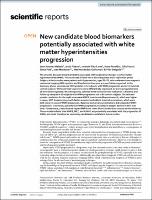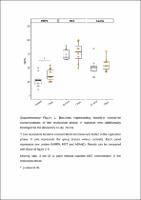| dc.contributor | Vall d'Hebron Barcelona Hospital Campus |
| dc.contributor.author | Jimenez Balado, Joan |
| dc.contributor.author | Pizarro Gonzálvez, Jesús |
| dc.contributor.author | Riba Llena, Yolanda |
| dc.contributor.author | Penalba Morenilla, Anna |
| dc.contributor.author | Faura Llorens, Julia |
| dc.contributor.author | Pala Vila, Elena |
| dc.contributor.author | Montaner Villalonga, Joan |
| dc.contributor.author | Hernandez Guillamon, Maria Mar |
| dc.contributor.author | Delgado Martínez, Maria Pilar |
| dc.date.accessioned | 2022-02-24T16:11:07Z |
| dc.date.available | 2022-02-24T16:11:07Z |
| dc.date.issued | 2021-07-12 |
| dc.identifier.citation | Jiménez-Balado J, Pizarro J, Riba-Llena I, Penalba A, Faura J, Palà E, et al. New candidate blood biomarkers potentially associated with white matter hyperintensities progression. Sci Rep. 2021 Jul 12;11:14324. |
| dc.identifier.issn | 2045-2322 |
| dc.identifier.uri | https://hdl.handle.net/11351/7076 |
| dc.description | Blood-brain barrier; Neuro-vascular interactions; Neuroscience |
| dc.description.abstract | We aimed to discover blood biomarkers associated with longitudinal changes in white matter hyperintensities (WMH). This study was divided into a discovery phase and a replication phase. Subjects in both studies were patients with hypertension, aged 50-70, who underwent two magnetic resonance imaging (MRI) sessions and blood extractions over a 4-year follow-up period. In the discovery phase, we screened 1305 proteins in 12 subjects with WMH progression and in 12 matched control subjects. We found that 41 proteins were differentially expressed: 13 were upregulated and 28 were downregulated. We subsequently selected three biomarkers for replication in baseline and follow-up samples in 80 subjects with WMH progression and in 80 control subjects. The selected protein candidates for the replication were MMP9 (matrix metalloproteinase-9), which was higher in cases, MET (hepatocyte growth factor receptor) and ASAH2 (neutral ceramidase), which were both lower in cases of WMH progression. Baseline biomarker concentrations did not predict WMH progression. In contrast, patients with WMH progression presented a steeper decline in MET over time. Furthermore, cases showed higher MMP9 and lower ASAH2 levels than controls at the follow-up. These results indicate that MMP9, MET, and ASAH2 are potentially associated with the progression of WMH, and could therefore be interesting candidates to validate in future studies. |
| dc.language.iso | eng |
| dc.publisher | Nature Research |
| dc.relation.ispartofseries | Scientific Reports;11 |
| dc.rights | Attribution 4.0 International |
| dc.rights.uri | http://creativecommons.org/licenses/by/4.0/ |
| dc.source | Scientia |
| dc.subject | Mielina - Metabolisme |
| dc.subject | Hipertensió |
| dc.subject | Marcadors bioquímics |
| dc.subject.mesh | White Matter |
| dc.subject.mesh | /metabolism |
| dc.subject.mesh | Hypertension |
| dc.subject.mesh | Biomarkers |
| dc.title | New candidate blood biomarkers potentially associated with white matter hyperintensities progression |
| dc.type | info:eu-repo/semantics/article |
| dc.identifier.doi | 10.1038/s41598-021-93498-w |
| dc.subject.decs | sustancia blanca |
| dc.subject.decs | /metabolismo |
| dc.subject.decs | hipertensión |
| dc.subject.decs | biomarcadores |
| dc.relation.publishversion | https://doi.org/10.1038/s41598-021-93498-w |
| dc.type.version | info:eu-repo/semantics/publishedVersion |
| dc.audience | Professionals |
| dc.contributor.organismes | Institut Català de la Salut |
| dc.contributor.authoraffiliation | [Jiménez-Balado J, Pizarro J, Riba-Llena I, Penalba A, Faura J, Palà E, Hernández-Guillamon M] Laboratori de Recerca Neurovascular, Vall d’Hebron Institut de Recerca (VHIR), Barcelona, Spain. Universitat Autònoma de Barcelona, Bellaterra, Spain. [Montaner J] Laboratori de Recerca Neurovascular, Vall d’Hebron Institut de Recerca (VHIR), Barcelona, Spain. Universitat Autònoma de Barcelona, Bellaterra, Spain. Institute de Biomedicine of Seville, IBiS/Hospital Universitario Virgen del Rocío/CSIC/University of Seville & Department of Neurology, Hospital Universitario Virgen Macarena, Seville, Spain. [Delgado P] Laboratori de Recerca Neurovascular, Vall d’Hebron Institut de Recerca (VHIR), Barcelona, Spain. Universitat Autònoma de Barcelona, Bellaterra, Spain. Unitat de Demència, Servei de Neurologia, Vall d’Hebron Hospital Universitari, Barcelona, Spain. Universitat Autònoma de Barcelona, Bellatera, Spain |
| dc.identifier.pmid | 34253757 |
| dc.identifier.wos | 000677494000010 |
| dc.relation.projectid | info:eu-repo/grantAgreement/ES/PE2013-2016/PI14%2F01535 |
| dc.relation.projectid | info:eu-repo/grantAgreement/ES/PE2013-2016/PI17%2F02222 |
| dc.relation.projectid | info:eu-repo/grantAgreement/ES/PE2013-2016/PI19%2F00217 |
| dc.relation.projectid | info:eu-repo/grantAgreement/ES/PE2013-2016/JR15%2F00032 |
| dc.relation.projectid | info:eu-repo/grantAgreement/ES/PERIS2016-2020/SLT006%2F17%2F00266 |
| dc.rights.accessrights | info:eu-repo/semantics/openAccess |


